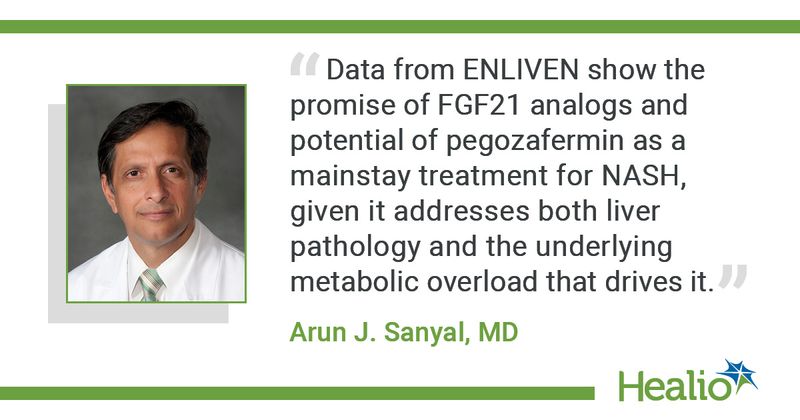Pegozafermin improves fibrosis, shows promise as ‘mainstay treatment’ for NASH
Click Here to Manage Email Alerts
Pegozafermin significantly improved fibrosis without worsening of nonalcoholic steatohepatitis, and vice versa, with similar efficacy reported at weekly and biweekly dosing intervals, according to late-breaker data at EASL Congress.
“As a physician, I know how important it is to provide patients with therapies that can be impactful across a broad population of individuals with NASH, especially ones that can easily blend into their daily lives,” Rohit Loomba, MD, MHSc, professor of medicine and chief of the division of gastroenterology and hepatology at University of California San Diego School of Medicine, said in a related 89bio press release. “It’s both incredibly encouraging and exciting to see the positive, consistent results from this research across all aspects — efficacy, safety, tolerability and dosing convenience.”

In a multicenter, randomized, double blind, phase 2b study, Loomba and colleagues investigated the safety and efficacy of pegozafermin compared with placebo among 222 patients (mean age, 56 years; 61% women; 66% type 2 diabetes; mean BMI, 37 kg/m2) with biopsy-proven fibrosis stage 2 or 3 (60% F3).
Participants received weekly pegozafermin 15 mg (n = 14) or 30 mg (n = 66), biweekly pegozafermin 44 mg (n = 51) or placebo (n = 61) for 24 weeks.

The primary endpoint was the proportion of patients with at least 1 stage fibrosis improvement without NASH worsening or resolution of NASH with no worsening of fibrosis. Secondary endpoints included histology measures, change in liver fat content, fibrosis and inflammatory markers, and metabolic effects.
According to study results, fibrosis improvement of at least 1 stage without worsening of NASH occurred among 22% of patients on weekly pegozafermin 15 mg, 26% on 30 mg, 27% on 44 mg and 7% on placebo. NASH resolution without worsening of fibrosis occurred among 37%, 23%, 26% and 2%, respectively.
In addition, researchers reported “statistically significant results” on the combined endpoint of fibrosis improvement and NASH resolution, with 14% of patients in the 30 mg group and 20% of patients in the 44 mg group achieving both. Further, 60% and 52%, respectively, had at least a 2-point improvement in NAFLD activity score, MRI proton density fat fraction and alanine transaminase response.
Pegozafermin was safe and well-tolerated, researchers reported, with the most common treatment-emergent adverse events including mild to moderate nausea and diarrhea.
“NASH is highly associated with metabolic syndrome and increased cardiovascular risk, driving its impact far beyond the liver,” Arun J. Sanyal, MD, interim chair of the division of gastroenterology, hepatology and nutrition at Virginia Commonwealth University, said in the release. “Data from ENLIVEN show the promise of [fibroblast growth factor 21] analogs and potential of pegozafermin as a mainstay treatment for NASH, given it addresses both liver pathology and the underlying metabolic overload that drives it.”
He continued: “I am thrilled to see the strong efficacy data across the two FDA-approvable histology endpoints, potential to benefit patients already on [glucagon-like peptide 1] therapies and the impressive results across markers of total liver health, which is critically important for this patient population.”
Reference:
- Data from 89bio’s ENLIVEN phase 2b trial of pegozafermin in patients with nonalcoholic steatohepatitis (NASH) published in The New England Journal of Medicine and simultaneously presented in a late-breaker session at the EASL International Liver Congress. Available at: https://ir.89bio.com/news-releases/news-release-details/data-89bios-enliven-phase-2b-trial-pegozafermin-patients. Published June 24, 2023. Accessed June 24, 2023.

